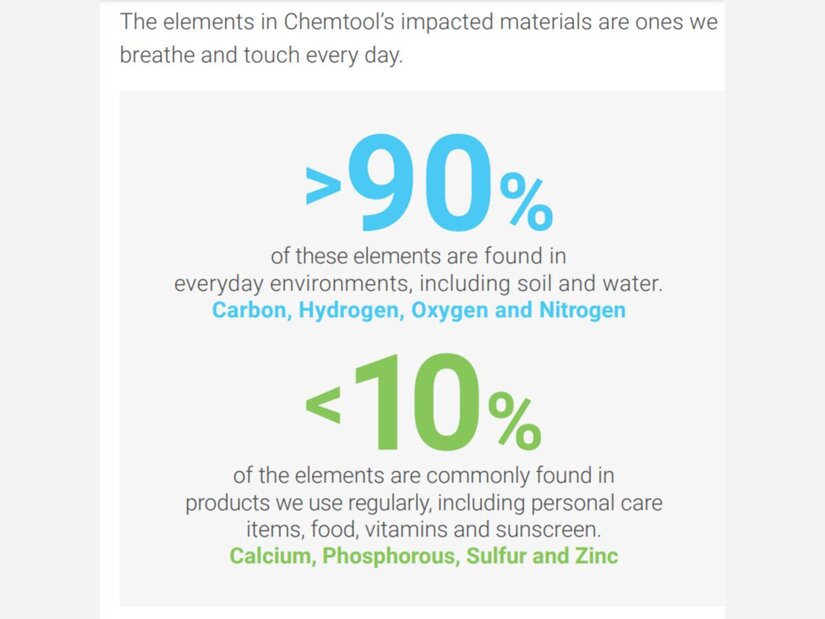Chemtool finally estimates what burned in the fire and what was released over Rockton
Parent company Lubrizol turned in the report exactly on the due date.

Like a procrastinating student, exactly on the due date, Chemtool's parent company Lubrizol has released an "emissions estimate report" [PDF] that lists the "amount of product combusted during the Fire" and "emissions that were a result of the Fire." The report came out on July 25, 2022, 90 days after an April 25 court order [PDF] told them to turn in "a written report identifying the contaminants released" within 90 days. If they didn't comply with the court order, the fine would be $400 for each day late, or $1000 per day after 30 days.
The Fire, of course, refers to the massive explosion and fire that broke out at 7 a.m. Monday morning, June 14, 2021, at Lubrizol's Chemtool facility at 1165 Prairie Hill Road in Rockton, Illinois. For four days, residents within a one mile area were required, then strongly encouraged, to evacuate. The smoke plume was visible for miles, as far as Madison and DeKalb. The fire was not fully extinguished until June 23, nine days after it began. Multiple lawsuits are still burning their way through the court system. The plant is closed.
Understandably, Rockton residents wanted to know what chemicals were in the smoke they breathed and the debris that fell on their lawns, even though the Illinois EPA found "no exceedances" of air pollutants. But for months, Lubrizol resisted providing a list of the materials. They reassured residents, "During a fire of this magnitude, products will convert to their elemental form or oxides of the elements. The elements in Chemtool’s impacted materials are ones we breathe and touch every day." But the April 25 court order set a deadline for the company to release the list.
Nobody else covers Rockton and Roscoe so deeply. Subscribe to our free newsletter!
According to the emissions estimate prepared by EHS Support, on the day of the fire, Chemtool had 23,612,732 pounds of chemicals at its plant, both raw materials and finished greases, mostly in the Warehouse (North Dock) and in the Grease Raw Material Bulk Tank Farm on the west. Of that, 1,815,020 pounds were non-combustible (such as water and calcium carbonate), 899,027 pounds were recovered after the fire (in storage tanks or mixed with water from the firefighters or collected from nearby soil), and 5,503,699 pounds were remaining. But the report estimates that 15,394,986 pounds of chemicals were combusted in the fire.
EHS Support says the fire turned 7,697 tons of combustible material into common components such as carbon dioxide (CO2) and water (H2O) - those two making up 96% of the total. But it also produced more dangerous emissions: smoke particulate matter (PM), carbon monoxide (CO), volatile organic compounds (VOCs), sulfur oxides (SOX), and nitrogen oxides (NOX). EHS Support estimates that the fire produced one thousand tons of smoke particles, almost 700 tons of carbon monoxide, almost 58 tons of VOCs, 19 tons of sulfur oxides, and 185 pounds of nitrogen oxides.
And what might have been in the smoke? EHS Support estimates it was 96% carbon, 965 tons of it. But it probably also contained more than 9 tons of calcium, 8 tons of potassium, 8 tons of sulfur, 3 tons of molybdenum, more than 2 tons of heavy metals (mostly zinc),1.6 tons of phosphorus, almost a ton of lithium, plus almost two tons of other materials, such as sodium, boron, silicon, aluminum, and titanium.
Of the nearly 58 tons of volatile organic compounds (VOCs) released by the Chemtool fire, EHS estimates 77% was the solvent acetone, as well as the solvent methyl ethyl ketone (12%), xylenes (3.60%), benzene (3.10%), styrene (1.60%), carbon disulfide (1.20%), toluene (1.20%), and ethylbenzene (0.67%).
Your support makes your local news happen!
Was the report worth waiting for? Dr. William Mills, an associate professor of Engineering and Engineering Technology at Northern Illinois University, who quickly looked over the report, told WREX he didn't think it provided "the level of definitive answer that people are looking for." For one thing, though the EPA monitored the air quality in Rockton throughout the incident, Lubrizol's report hardly mentions any of their findings. Instead of real world data from Rockton, says Mills, the report is based on theoretical numbers from controlled burn research done 25 years ago. In his opinion, the report could have at least cited information from the Lubrizol fire in Rouen, France in 2019. And he suspects Polycyclic Aromatic Hydrocarbons (PAHs) were part of the fire, even though none were found in the samples.
The report repeatedly talks about the necessity of "site-specific data." With all the air and water testing at the time, there should have been no lack of that. For nine days, the EPA measured smoke particles, carbon monoxide, hydrogen sulfide, and VOC levels in the air over Rockton - including during Old Settlers Days, which was not canceled but held outside the evacuation zone. Chemtool also hired CTEH to do air monitoring and the National Guard collected and analyzed samples. The water used for fighting the fire was collected in frac tanks. Yet EHS, for several reasons, says this data wasn't good enough to be used in this report. One missing piece, says the EHS report, is background samples. Without that, they say, they can't tell what was in the air normally and what was added to the air because of the fire.
Related stories from our Chemtool archive
- Looks like Chemtool payments weren't sent in February
- Update on Chemtool, sort of
- Why your property value affects your Chemtool settlement
- Chemtool payments waiting on assessed property values
- Chemtool payments expected to be sent at end of January
- Chemtool deadline is Saturday, Nov. 23, 2024
- Residents will be able to resubmit Chemtool claims that didn't go through
- Chemtool claims from more than 100 Rockton residents may be missing
- Missing Chemtool claims are being investigated
- Judge approves Chemtool settlement
- Residents near Chemtool can file claims for a portion of the $94.5 million settlement
- Judge will issue preliminary approval of Chemtool settlement in next few weeks
- Blackhawk Acres residents can connect to Rockton water at no charge
- The unfolding legal chronicles of Chemtool, Lubrizol, Rockton, and Holian
- Chemtool cleans up, lawsuits warm up
- The EPA found metals in Rockton water in 2004, but not enough to keep testing for them.
- Heavy metals found in Rockton neighborhood groundwater, may not be new
- Chemtool finally estimates what burned in the fire and what was released over Rockton
- Chemtool hasn't released list of materials, says fire reduced everything to its elemental form
- Chemtool fire: officials claim they're gathering information, not holding it back
- Chemtool responds to state lawsuit
- State attorneys file suit against Chemtool for environmental recovery
- Environmental expert: be concerned about years, not days, of exposure to chemicals
- Rockton fire chief: Chemtool contractor released mineral oil, ignition occurred
- Chemtool fire dwindles, cleanup continues, lawsuits emerge
- Rockton air quality remains stable, Chemtool will pay for debris cleanup and evacuee expenses
- Chemtool employees still being paid, Rockton still under evacuation order
- Lubrizol employees in France think they've seen this smoke plume before
- Gov. Pritzker sends National Guard to respond to chemical fire in Rockton






